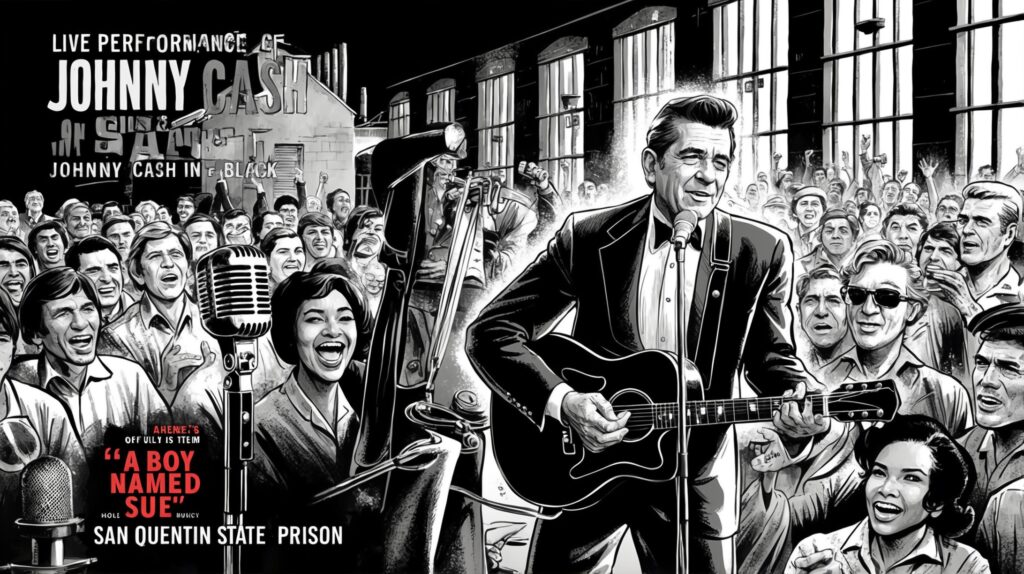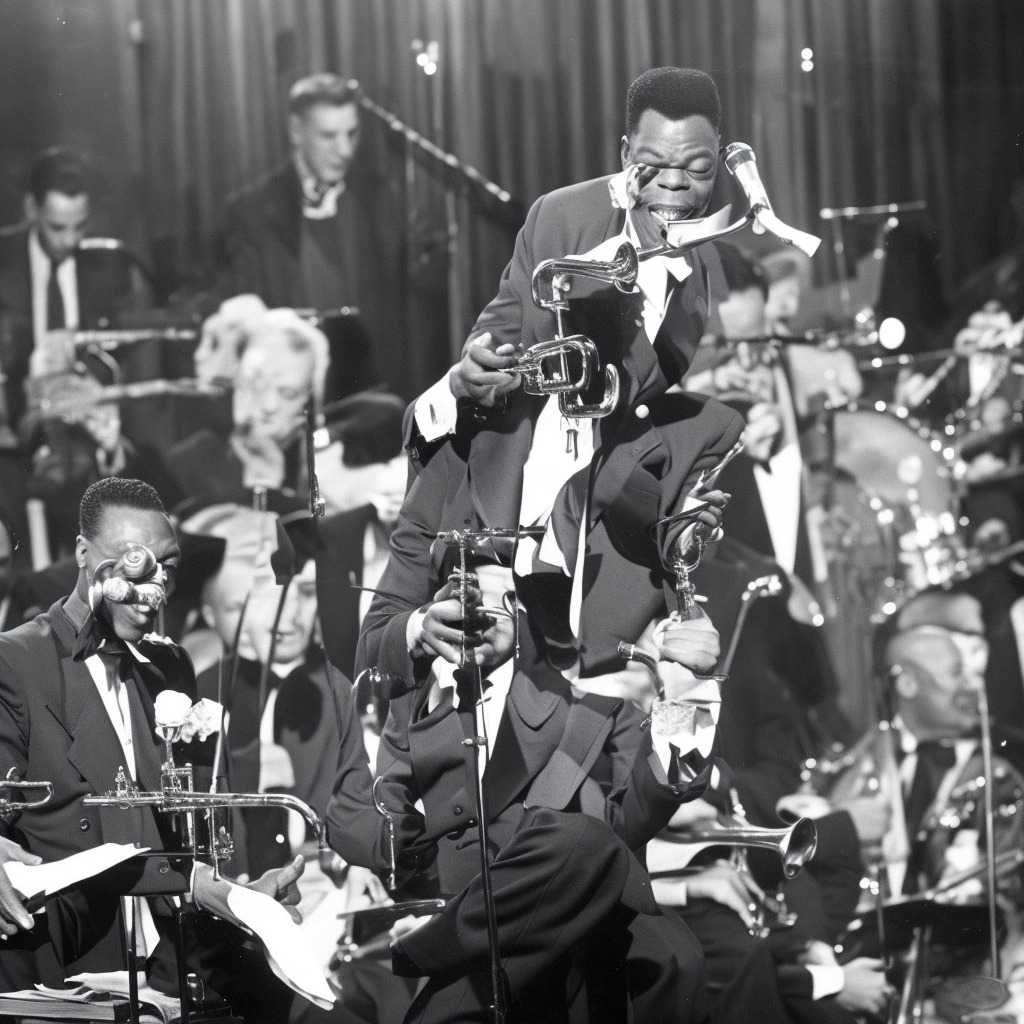The Man in Black: Johnny Cash’s Journey
Johnny Cash, the legendary Man in Black, crafted songs that blended humor and raw emotion, impacting American music profoundly. Born in Arkansas, Cash’s authenticity resonated in his storytelling, reaching a peak with the release of ‘A Boy Named Sue’ in the late 60s, during a creatively rich period marked by powerful collaborations.

Johnny Cash, known as the Man in Black, is an indelible figure in the landscape of American music. His deep voice, unique sound, and authentic storytelling have left an indelible mark on country and rock music alike. “A Boy Named Sue,” one of his most infamous songs, stands as a testament to Cash’s prowess as a storyteller, blending humor, raw emotion, and a deep understanding of human experience.
Born in 1932 in Kingsland, Arkansas, Cash’s early life was steeped in the rich, sometimes challenging textures of rural America. His upbringing in a farming family informed much of his music, giving him a grounded authenticity that resonated with audiences. Cash first entered the music scene in the 1950s, initially navigating the burgeoning rockabilly trend. His early recordings with Sam Phillips at Sun Records—alongside legends like Elvis Presley and Jerry Lee Lewis—set the stage for his rise to fame.
By the late 1960s, when “A Boy Named Sue” was released, Cash had firmly established himself as a major force in music. This period was a particularly creative time for the artist, marked by distinctive collaborations and live performances, including the celebrated 1969 concert at San Quentin State Prison where he first performed “A Boy Named Sue.” This era highlighted Cash’s knack for selecting and shaping songs that reflected his persona and spoke to the everyday experiences of diverse audiences. His partnership with his wife, June Carter Cash, during this period, also fueled various successful artistic endeavors that amplified his already significant impact on the music scene of the time.
The Literary Wit of Shel Silverstein
Dive into the creative genius of Shel Silverstein, the composer behind ‘A Boy Named Sue,’ and explore how his rich storytelling and eclectic musical style shaped the song.
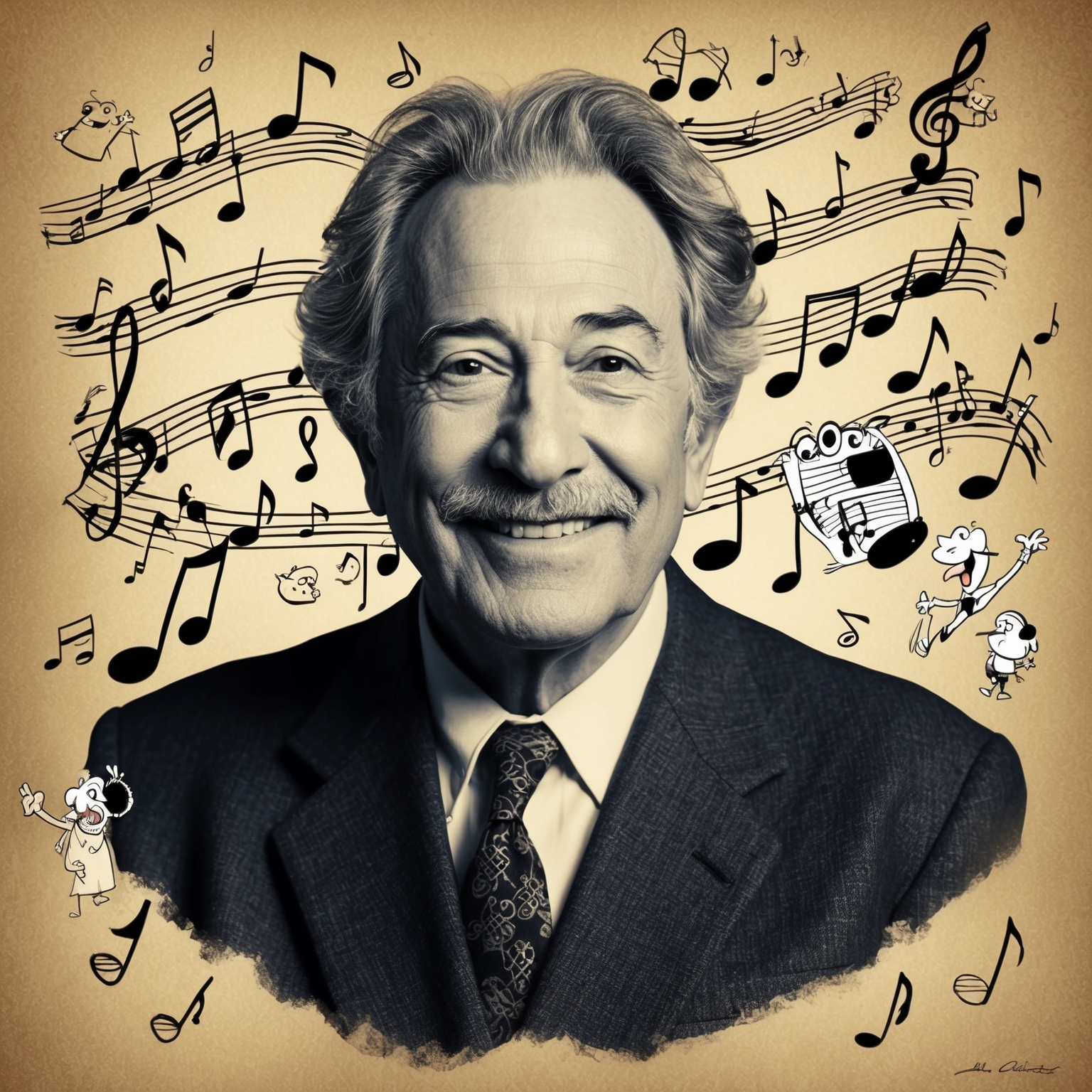
Shel Silverstein, renowned for his whimsical children’s books, was a man of many talents. Born in 1930 in Chicago, Illinois, Silverstein’s early career was marked by a diverse array of creative pursuits. From cartooning for ‘Playboy’ magazine to writing songs for leading artists, his eclectic talent knew no bounds. Silverstein had no formal musical training yet he became an influential figure in the music industry, perhaps due in part to the unique quality of his lyrics and his ability to capture complex emotions with simplicity and humor.
Known primarily for his work in children’s literature, such as ‘The Giving Tree’ and ‘Where the Sidewalk Ends,’ Silverstein’s musical style was just as diverse. His forays into country, rock, and folk music were influenced by the cultural movements of the time, as well as by other musicians and storytellers. His collaboration with artists like Johnny Cash underscored his adaptability and genius in merging poetic storytelling with musical rhythm.
Shel Silverstein’s touch on ‘A Boy Named Sue’ was crucial. The combination of his witty, conversational lyrics and Johnny Cash’s iconic voice created a memorable hit that resonated with audiences. Silverstein’s storytelling prowess is evident in the way he crafted the humorous yet poignant tale of a boy dealing with the struggles of an unusual name. This balance of humor and depth in his composition played a pivotal role in the song’s success and enduring popularity.
Recognitions and Renderings: “A Boy Named Sue” Through the Years
“A Boy Named Sue” by Johnny Cash won a Grammy in 1970 and has been covered by artists like Shel Silverstein and Bobby Bare. It also featured in popular culture, including the film “Logan Lucky.”
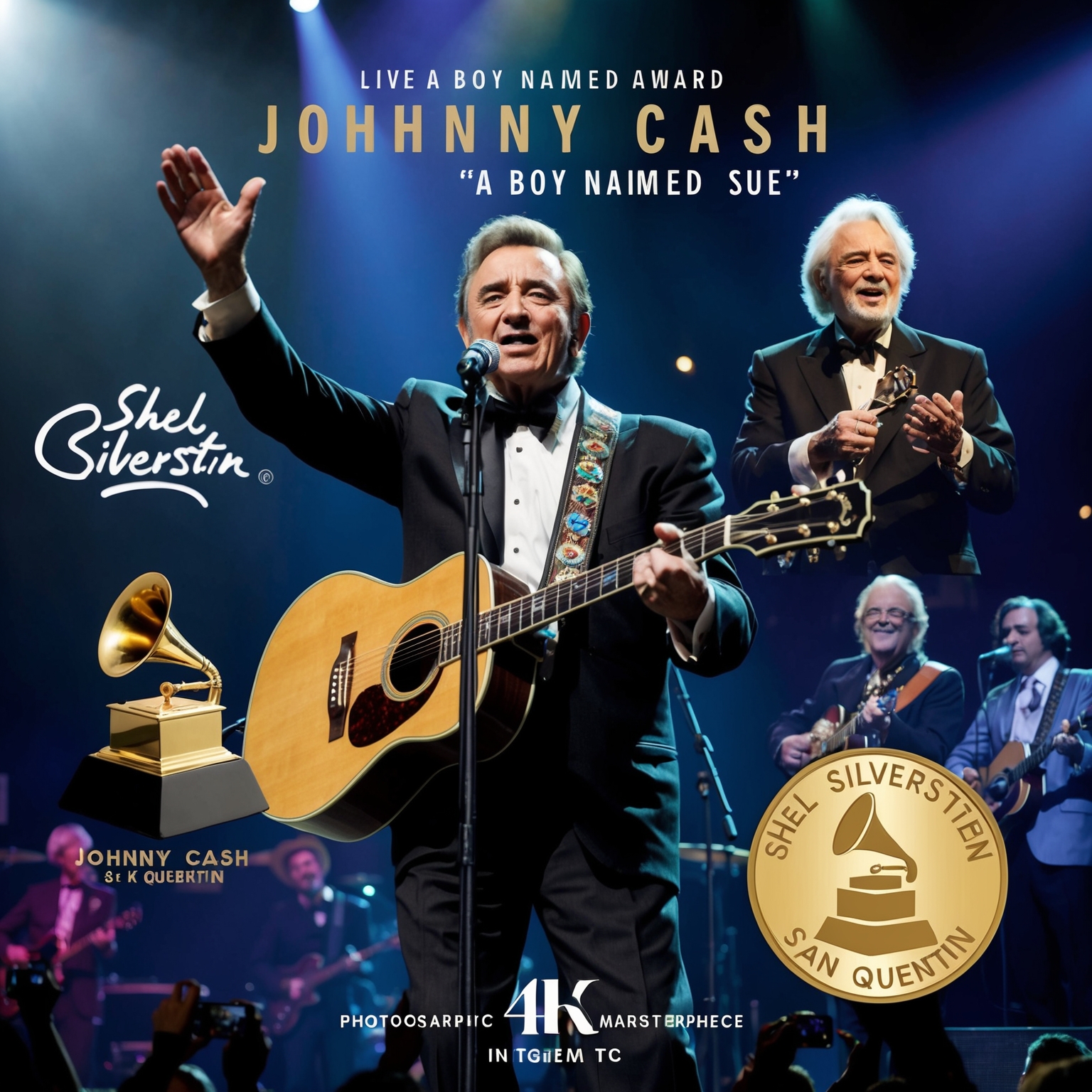
Award Highlights
The song “A Boy Named Sue” by Johnny Cash hasn’t just resonated with audiences globally since its release; it has also garnered notable recognition in the music industry. Recorded live at San Quentin State Prison, this unique setting allowed the song to clinch a Grammy Award in 1970 for Best Male Country Vocal Performance. This accolade solidified Johnny Cash’s status as a formidable storyteller in the annals of country music.
Notable Covers and Renditions
Over the years, “A Boy Named Sue” has inspired various artists to offer their own renditions, each adding a unique twist to the iconic number. Perhaps most famously, Shel Silverstein, the original songwriter, recorded his own version, remaining faithful to the wit and humor that characterizes the lyrics. Additionally, artists like Shel’s young protégé, Bobby Bare, also covered the song, showing that the humor and narrative storytelling of Cash’s performance transcend generations and musical styles.
Appearances in Popular Culture
“A Boy Named Sue” has made its mark on popular culture beyond the music charts. It found a place in the 2016 film “Logan Lucky,” directed by Steven Soderbergh, where it acted as a nostalgic backdrop that blended perfectly with the film’s themes of unconventional justice. The song’s unique narrative style has made it a fascinating fit for movies and even TV shows seeking a blend of humor and pathos.
“A Boy Named Sue” has undeniably left its imprint across various media, continuing to be celebrated and reinterpreted in multiple forms.
Charting New Territories: ‘A Boy Named Sue’ and Its Meteoric Rise
Trace the meteoric rise of ‘A Boy Named Sue’ as it broke barriers on the charts, resonated with diverse audiences, and became a landmark in Johnny Cash’s career and country music history.
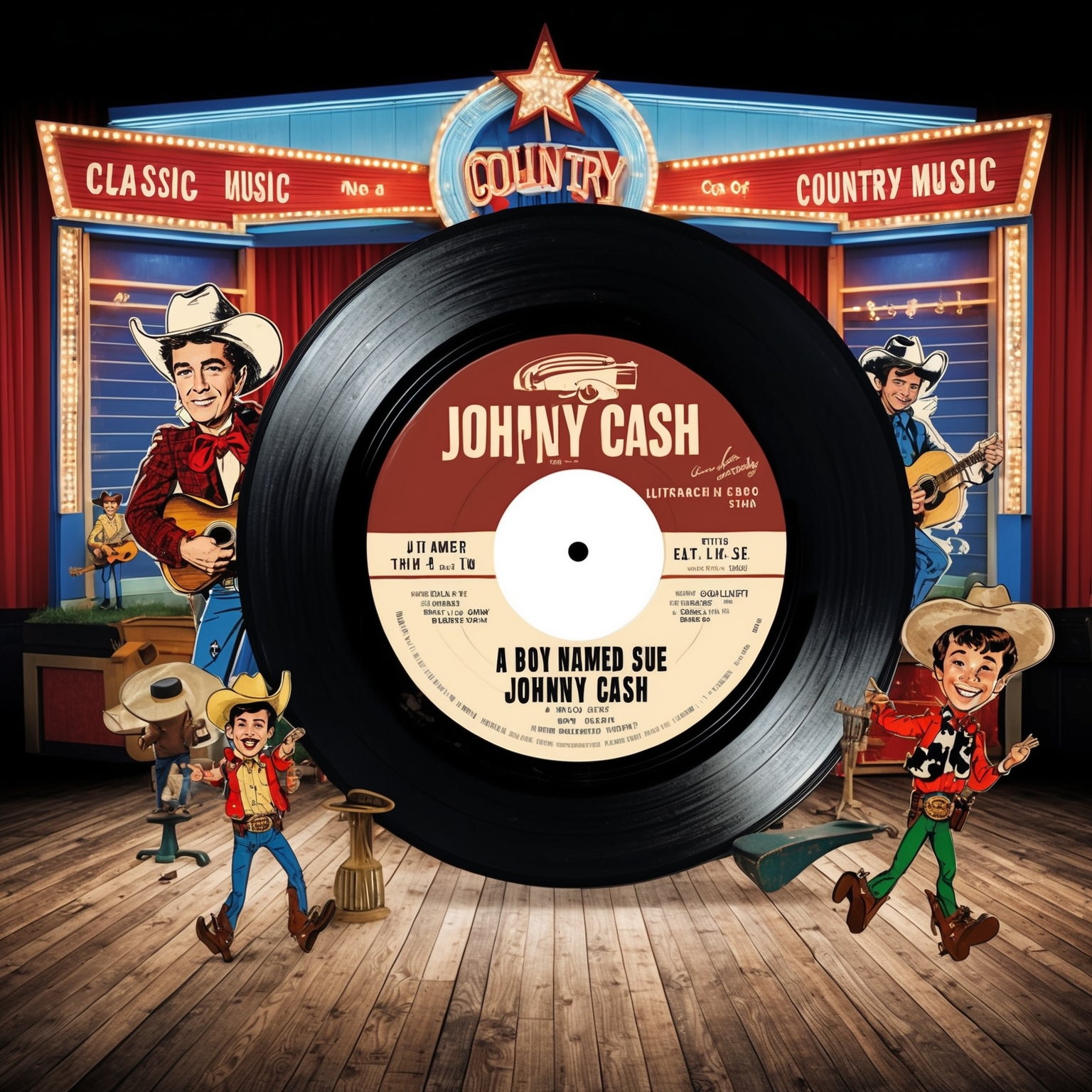
Johnny Cash’s ‘A Boy Named Sue’ charted a remarkable trajectory from the moment it was released. Dropping in July 1969, this iconic single quickly became a staple on music charts around the world. It debuted on the Billboard Hot 100, and to the delight of Cash’s fans, it didn’t take long to climb to an impressive peak position of number two. This was a significant achievement not just for Cash, but for country music, as it marked one of the rare instances where a country song penetrated the predominantly pop-focused charts.
When compared to other songs during its release period, ‘A Boy Named Sue’ was a breath of fresh air. While popular tracks of the time tended to revolve around themes of love and peace given the cultural zeitgeist of the late 1960s, Cash’s humorous and narrative approach stood out. This contrast in lyrical storytelling helped the song achieve broad appeal beyond Cash’s traditional country fan base. It resonated with an audience that was beginning to appreciate more diverse musical storytelling.
The success of ‘A Boy Named Sue’ was a pivotal moment in Johnny Cash’s illustrious career. It acted both as a triumphant follow-up to his previous hits and as a crucial piece that solidified his status as a crossover artist. Capitalizing on this success, Cash and his label employed innovative marketing strategies at the time, including live performances of the song at festivals and concerts that captured his raw energy and charisma, thereby driving further interest and pushing album sales.
Critically, the song was met with enthusiasm, lauded for its clever lyrics and narrative depth. The public adored it, making it a singalong staple of concerts and a fixture in Cash’s setlists for years to come. Its cultural impact has lingered long after its debut, influencing artists from various genres who appreciated Cash’s penchant for authentic storytelling. ‘A Boy Named Sue’ became not just a hit but a cultural reference point, often cited in discussions of songs with enduring legacies.
Imagining ‘A Boy Named Sue’ Through Visuals
While ‘A Boy Named Sue’ lacks an official music video, fan interpretations and live performances, like the one at San Quentin, offer vivid visual narratives that enhance its storytelling.

Johnny Cash’s ‘A Boy Named Sue’ does not have an official music video, but the song’s engaging narrative has inspired numerous creative visual interpretations over the years. Fans and creators have taken the timeless tale of Sue and his quest for revenge and reconciliation with his father to share their visual perspectives through fan-made videos and animations. These interpretations often highlight the song’s themes of humor, resilience, and the complexities of identity and family dynamics.
A particularly notable visual representation is the live performance of ‘A Boy Named Sue’ at the infamous San Quentin State Prison in 1969. This live version captures the raw energy and authenticity of Cash’s performance, bringing an added element to the song’s storytelling. In this rendition, Cash’s engaging presence and storytelling prowess are front and center, with his expressive delivery and connection with the audience amplifying the song’s impact. The visuals of Cash interacting with the inmates reflect the universality of the song’s message, resonating with audiences beyond its initial release.
Additionally, various fan videos have added to the song’s popularity, merging different styles and creative interpretations. Some videos use animation to illustrate the humorous yet tense moments of the narrative, while others employ a more cinematic approach to highlight the emotional depth of the father-son confrontation. These fan creations contribute to the song’s enduring appeal by offering diverse lenses through which its story can be appreciated. Though unofficial, these visual representations continue to garner attention and praise, demonstrating the powerful connection listeners feel with the song’s themes and Johnny Cash’s iconic storytelling.
Diving into the Musical Blueprint of ‘A Boy Named Sue’
A Boy Named Sue’ by Johnny Cash employs a simple yet powerful musical structure, characterized by its key, tempo, and instrumentation, enhancing its narrative style. This song captures a pivotal point in Cash’s discography, marked by thematic evolution and live recording authenticity.
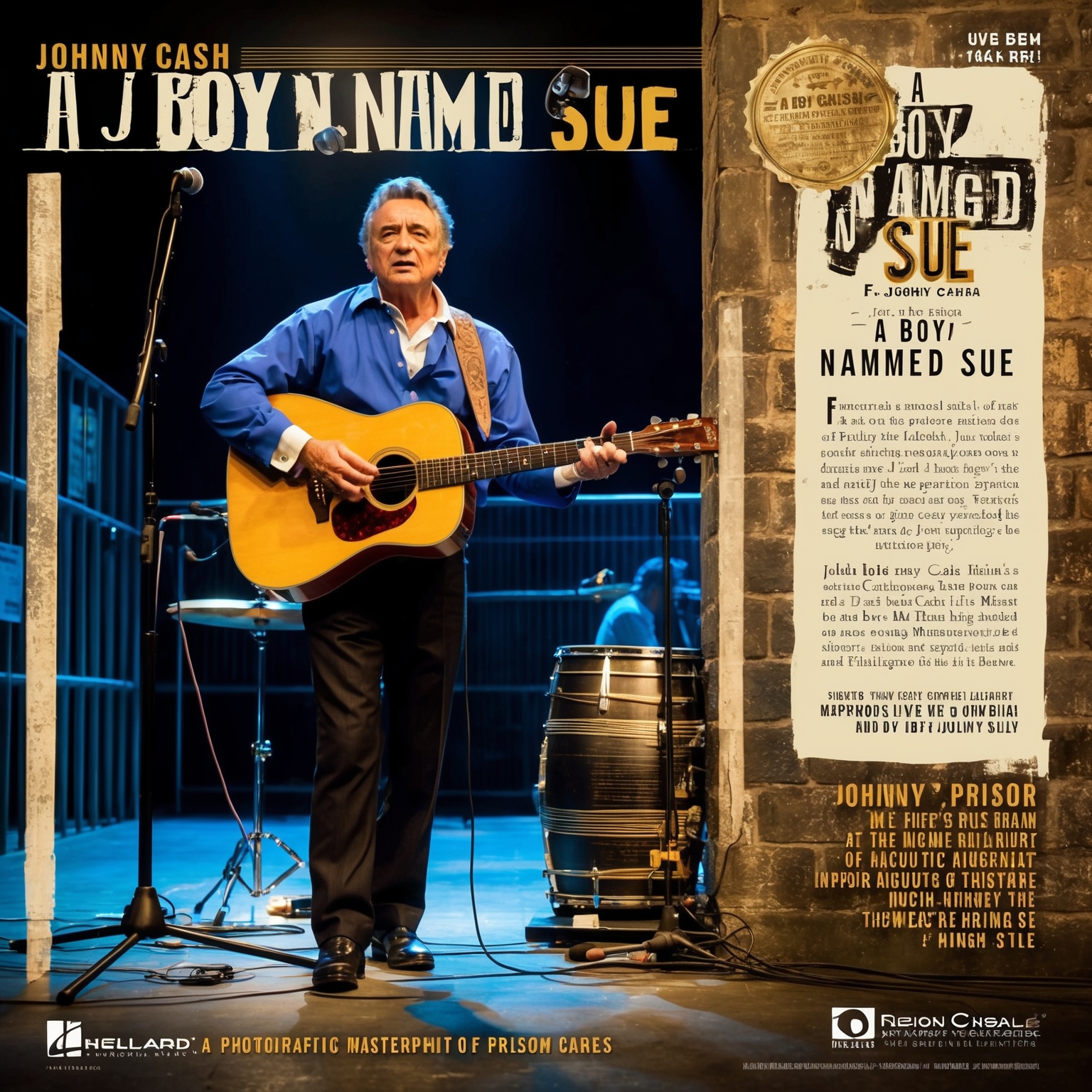
When examining the structure of Johnny Cash’s ‘A Boy Named Sue,’ it becomes evident that this composition stands out not only for its lyrical storytelling but also for its intriguing musical configuration. The song is written in the key of F major, which enhances its narrative vibrant energy while keeping the chords simple yet effective. The chord progression generally adheres to basic blues and country patterns, primarily revolving around F, Bb, and C chords, establishing an easy-to-follow musical journey that aligns with Cash’s straightforward narrative style.
The tempo of ‘A Boy Named Sue’ is steady and moderate, allowing the lyrics’ articulation to shine through, characteristic of Cash’s iconic delivery. The song travels at a pace of about 104 beats per minute, keeping listeners engaged without overwhelming them. This tempo permits Cash to employ varying vocal dynamics, enhancing the story’s emotional intensity as it unfolds.
Harmonically, the song pardons complexity in favor of rhythmic and melodic appeal. The melody follows a conversational flow, taking cues from traditional country and folk influences, which suits the storytelling format effectively. Instrumentation is sparse yet purposefully aligned. With the classic acoustic guitar at its forefront, complemented by rhythmic percussion and a plucky bass, the song achieves its distinctive sound that emphasizes the lyrical content rather than overshadowing it.
‘A Boy Named Sue’ marks a significant moment in Johnny Cash’s discography, exemplifying his blending of humor and harsh reality within musical storytelling. When compared to earlier works such as ‘Folsom Prison Blues,’ this song reflects an evolution in Cash’s thematic reach, intertwining a more narrative-like lyrics composition with a simplicity that appeals to a wide audience. The song represents Cash’s capacity to translate complex emotional journeys into relatable musical experiences, reinforcing his legacy in the music world.
Recorded live during Cash’s performance at San Quentin State Prison, the atmospheric gravitas captured during the session further enriches the song’s authenticity. Produced by the legendary Bob Johnston, the spontaneity and vibrancy of Cash’s performance were skillfully captured, adding layers to the song’s raw and unpolished charm.
Exploring the Depths of ‘A Boy Named Sue’
An in-depth exploration of Johnny Cash’s ‘A Boy Named Sue,’ examining its narrative style, themes of resilience and identity, and use of literary devices. Discover how cultural references and emotional depth contribute to the song’s lasting impact.
Well, my daddy left home when I was three
Didn’t leave very much to my mom and me
Except this old guitar and an empty bottle of booze
Now I don’t blame him ’cause he run and hid
But the meanest thing that my daddy ever did
Was before he left, he went and named me Sue
Well, he must’ve thought that it was quite a joke
And I got a lot of laughs from a lots of folk
Seems I had to fight my whole life through
Some gal would giggle and I’d turn red
And some guy’d laugh and I’d bust his head
I tell you, life ain’t easy for a boy named Sue
But I grew up quick and I grew up mean
My fist got hard and my wits got keener
Roam from town to town to hide my shame
But I made me a vow to the moon and stars
I’d search the honky tonks and bars
And kill that man that gave me that awful name
Well, it was Gatlinburg in mid-July
And I just hit town and my throat was dry
Thought I’d stop and have myself a brew
…
******* This Lyrics is NOT for Commercial use *******
 Lyrical Themes and Messages: ‘A Boy Named Sue’ by Johnny Cash tackles themes that are both personal and universal. At its core, the song is about identity and resilience. Through its narrative, the lyrics explore the struggles and challenges faced by the titular character, Sue, who is given a name traditionally perceived as feminine. This choice becomes a significant life hurdle, serving as a catalyst for personal strength and determination. The song resonates with listeners by highlighting the courage required to overcome societal expectations and personal suffering. Released during a time of cultural shifts in the late 1960s, this theme of personal battle was particularly poignant.
Lyrical Themes and Messages: ‘A Boy Named Sue’ by Johnny Cash tackles themes that are both personal and universal. At its core, the song is about identity and resilience. Through its narrative, the lyrics explore the struggles and challenges faced by the titular character, Sue, who is given a name traditionally perceived as feminine. This choice becomes a significant life hurdle, serving as a catalyst for personal strength and determination. The song resonates with listeners by highlighting the courage required to overcome societal expectations and personal suffering. Released during a time of cultural shifts in the late 1960s, this theme of personal battle was particularly poignant.
Narrative and Storytelling: The storytelling in ‘A Boy Named Sue’ is both engaging and vivid, told from a first-person perspective. This approach allows the audience to connect more deeply with Sue’s experiences and emotions. The narrative is linear yet dynamic, capturing Sue’s journey from childhood through adulthood with humor and grit. This autobiographical style, combined with Cash’s distinctive vocal delivery, contributes significantly to the song’s impact, creating a tale that feels both personal and epic.
Use of Literary Devices: Johnny Cash effectively uses a range of literary devices in ‘A Boy Named Sue.’ Alliteration, rhyme schemes, and metaphors abound, enriching the story with texture and wit. The recurring rhyme structure underscores the rhythm, making the song catchy and memorable. Meanwhile, vivid imagery, such as ‘fist got hard and my wits got keener,’ paints a picture of Sue’s toughening journey. This clever wordplay not only enhances the storytelling but also amplifies the emotional resonance, making the song accessible and powerful.
Cultural and Social References: While the story itself is fictional, it hints at the broader social context of growing up in a rigidly gendered world. The name ‘Sue,’ unexpectedly given to a boy, becomes a symbol of adversity and societal judgment, provoking reflections on masculinity and identity. Through these references, Cash invites listeners to explore ideas about names, expectations, and the lengths one may go to reshape their own destiny.
Emotional Impact and Relatability: The emotional journey within the song—from anger and humiliation to understanding and forgiveness—strikes a chord with many listeners. It’s a narrative of self-discovery, resilience, and ultimately, acceptance. By endearing the audience to Sue’s struggles, Cash succeeds in crafting a relatable tale, one of perseverance against all odds. This emotional connection is perhaps why ‘A Boy Named Sue’ became a staple in Cash’s repertoire and remains enduringly popular.
🎶 Did you know? Johnny Cash recorded A Boy Named Sue LIVE at San Quentin! The song’s humor & punch made it a #Grammy hit in 1970! #MusicTrivia #JohnnyCash #ABoyNamedSue 🎤✨ tinyurl.com/3rh5bn47
Click to Tweet

